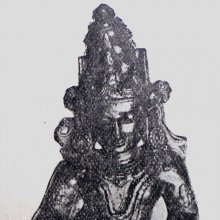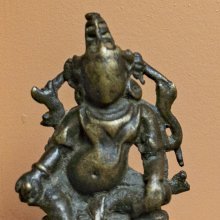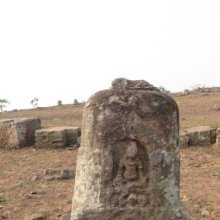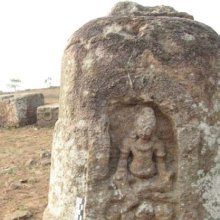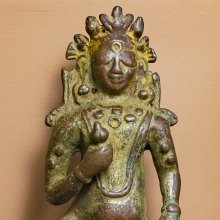Jambhala, Jambhalā: 15 definitions
Introduction:
Jambhala means something in Buddhism, Pali, Hinduism, Sanskrit, Marathi, biology. If you want to know the exact meaning, history, etymology or English translation of this term then check out the descriptions on this page. Add your comment or reference to a book if you want to contribute to this summary article.
Images (photo gallery)
(+13 more images available)
In Hinduism
Dharmashastra (religious law)
Source: Wisdom Library: Dharma-śāstraJambhala (जम्भल) is a Sanskrit word, identified with Citrus limonum (lime) by various scholars in their translation of the Śukranīti. This tree is mentioned as bearing good fruits. The King should plant such domestic plants in and near villages. He should nourish them by stoole of goats, sheep and cows, water as well as meat.
The following is an ancient Indian recipe for such nourishment of trees:
According to Śukranīti 4.4.105-109: “The trees (such as jambala) are to be watered in the morning and evening in summer, every alternate day in winter, in the fifth part of the day (i.e., afternoon) in spring, never in the rainy season. If trees have their fruits destroyed, the pouring of cold water after being cooked together with Kulutha, Māṣa (seeds), Mudga (pulse), Yava (barley) and Tila (oil seed) would lead to the growth of flowers and fruits. Growth of trees can be helped by the application of water with which fishes are washed and cleansed.”

Dharmashastra (धर्मशास्त्र, dharmaśāstra) contains the instructions (shastra) regarding religious conduct of livelihood (dharma), ceremonies, jurisprudence (study of law) and more. It is categorized as smriti, an important and authoritative selection of books dealing with the Hindu lifestyle.
Shaktism (Shakta philosophy)
Source: Google Books: ManthanabhairavatantramJambhalā (जम्भला) is associated with Khaḍgīśa: one of the nine Bhairava associated with the nine energies of Navātman, according to the Manthānabhairavatantra, a vast sprawling work that belongs to a corpus of Tantric texts concerned with the worship of the goddess Kubjikā.—[Note: this passage is drawn from the Gurukramasūtra]—Another way in which the nine energies of Navātman may be understood are as nine aspects of the Command that generates the Bhairavas corresponding to its nine letters. [...] In this case Navātman is SHKṢMLVRYŪ(Ṃ): [...] Khaḍgīśa (Va) is the son of Jambhalā. [...] (This) is the excellent teacher within the tradition. He who knows the teacher here is the delight of Kula.

Shakta (शाक्त, śākta) or Shaktism (śāktism) represents a tradition of Hinduism where the Goddess (Devi) is revered and worshipped. Shakta literature includes a range of scriptures, including various Agamas and Tantras, although its roots may be traced back to the Vedas.
In Buddhism
Tibetan Buddhism (Vajrayana or tantric Buddhism)
Source: Wisdom Library: Tibetan BuddhismJambhala (जम्भल) is the name of a deity summoned by the Yamāntaka-mantra and mentioned as attending the teachings in the 6th century Mañjuśrīmūlakalpa: one of the largest Kriyā Tantras devoted to Mañjuśrī (the Bodhisattva of wisdom) representing an encyclopedia of knowledge primarily concerned with ritualistic elements in Buddhism. The teachings in this text originate from Mañjuśrī and were taught to and by Buddha Śākyamuni in the presence of a large audience (including Jambhala).
Source: archive.org: The Indian Buddhist Iconography1) Jambhala (जम्भल) refers to one of the various emanations of Akṣobhya having their Sādhana described in the 5th-century Sādhanamālā (a collection of sādhana texts that contain detailed instructions for rituals).—He has three faces and six arms.—Jambhala has undoubtedly a greater antiquity behind him than that of the five Dhyāni Buddhas. Jambhala again is a Yakṣa and that indicates his non-Buddhist origin. This may be one of reasons whyhe could not be assigned to any one as parental Dhyāni Buddha. In other words Jambhala is similar to Mañjuśrī whose sire also could not be definitely determined.
The Dhyāna (meditation instructions) of Jambhala described in the Sādhanamālā as follows:—
“The worshipper should conceive himself as Jambhala, three-faced and six-armed, on whose matted hair there is an image of Akṣobhya. He carries in his three right hands the citron, the goad and the arrow. He embraces the Prajñā with the first left hand, carries the mongoose tied round with a lasso and the arrow respectively inthe second and the third. Thus meditating...”.
[Though the Dhyāna does not mention the colour, it can be presumed that his colour is blue which is the colour of the Dhyāni Buddha Akṣobhya from whom he takes his origin. Jambhala as the god of wealth commanded great respect amongst the Buddhists, and received worship in various forms in all Buddhist countries]
2) Jambhala (जम्भल) also refers to one of the various emanations of Ratnasambhava.—The characteristic feature of Jambhala emanating from Ratnasambhava is that he carries the mongoose in his right hand and the citron in the left. The mongoose is supposed to be the receptacle of all gems and jewels, and when Jambhala presses the two sides of the mongoose it vomits the treasures within... As an emanation of Ratnasambhava he may either be represented alone, or in the embrace of his Śakti in Yab-Yum.
Jambhala (single variety).—The Dhyāna (meditation instructions) in the Sādhanamālā is described as follows:—
[When single, Jambhala is of golden complexion and carries the mongoose in the left hand and the citron in the right. [...] A stone image from Nepal ... the god is represented as sitting in the Lalita attitude. Two other specimen from Vikrampur, in Eastern Bengal, depict the god in the same attitude, and they are some of the finest products of the Bengal art of medieval times.]
Jambhala (Yab-Yum form, first variety).—The Dhyāna (meditation instructions) in the Sādhanamālā is described as follows:—
[When represented in Yab-Yum, he sits on the moon under which there is a double lotus of eight petals. He wears all sorts of ornaments, his complexion is golden yellow and he [has a] protruding belly, He carries the citron and the mongoose in the right and left hands respectively, wears a garland of yellow lotus, a and remains in Yab-Yum with Vasudhārā. The eight petals of the lotus seat are occupied by the eight Yakṣas, to wit, Māṇibhadra, Pūrṇabhadra, Dhanada, Vaiśrayaṇa, Kelimālī, Civikuṇḍalī, Sukhendra and, Carendra who are identical in all respects with the principal figure. Each Yakṣa is accompanied by a Śakti with whom he remains in Yab-Yum in the same way as Jambhala remains with Vasudhārā, and the names of these eight Yakṣiṇīs are: Citrakālī, Dattā, Sudattā, Āryā, Subhadrā, Guptā, Devī and Sarasvatī. The Yakṣiṇīs are identical in form with Vasudhārā, who is yellow in complexion, carries the ears of corn and shows the Varada-mudrā in her two hands.]
Jambhala (Yab-Yum form, second variety).—[His Colour is white; he has three faces and six arms.]—The Dhyāna (meditation instructions) in the Sādhanamālā is described as follows:—
[Jambhala in Yab-Yum has another form with three faces, six arms and white colour. According to the Sādhana his two faces to the light and left are red and blue respectively, Jambhala sits in the vajraparyaṅka attitude, and embraces his Prajñā Vasudhārā of his own creation with the two principal hands. In the two remaining right hands he carries the red vajra and the sword, and in the two remaining left hands he holds the emerald and the lotus. In all other respects he is identical with the forms described previously.]
Note: Another variety is known as Ucchuṣma-Jambhala.

Tibetan Buddhism includes schools such as Nyingma, Kadampa, Kagyu and Gelug. Their primary canon of literature is divided in two broad categories: The Kangyur, which consists of Buddha’s words, and the Tengyur, which includes commentaries from various sources. Esotericism and tantra techniques (vajrayāna) are collected indepently.
Biology (plants and animals)
Source: Google Books: CRC World Dictionary (Regional names)1) Jambhala in India is the name of a plant defined with Calotropis gigantea in various botanical sources. This page contains potential references in Ayurveda, modern medicine, and other folk traditions or local practices It has the synonym Streptocaulon cochinchinense (Lour.) G. Don (among others).
2) Jambhala is also identified with Citrus aurantium It has the synonym Citrus bigarradia Loisel. (etc.).
Example references for further research on medicinal uses or toxicity (see latin names for full list):
· Annales du muséum national d’histoire naturelle (1813)
· Contraception. (2007)
· Chem. Pharm. Bull. (Tokyo) (2007)
· Caryologia (1985)
· Species Plantarum (1753)
· Science and Culture (1980)
If you are looking for specific details regarding Jambhala, for example extract dosage, pregnancy safety, chemical composition, diet and recipes, health benefits, side effects, have a look at these references.

This sections includes definitions from the five kingdoms of living things: Animals, Plants, Fungi, Protists and Monera. It will include both the official binomial nomenclature (scientific names usually in Latin) as well as regional spellings and variants.
Languages of India and abroad
Marathi-English dictionary
Source: DDSA: The Molesworth Marathi and English Dictionaryjāmbhaḷā (जांभळा).—& jāmbhūḷa See jāmbaḷā & jāmbūḷa.
Source: DDSA: The Aryabhusan school dictionary, Marathi-Englishjāmbhaḷā (जांभळा).—a Of a dark purple.
Marathi is an Indo-European language having over 70 million native speakers people in (predominantly) Maharashtra India. Marathi, like many other Indo-Aryan languages, evolved from early forms of Prakrit, which itself is a subset of Sanskrit, one of the most ancient languages of the world.
Sanskrit dictionary
Source: DDSA: The practical Sanskrit-English dictionaryJambhala (जम्भल) or Jambhalā (जम्भला).—A female Rākṣasī (by meditating on whom women are said to become pregnant).
Derivable forms: jambhalaḥ (जम्भलः).
See also (synonyms): jambhara.
Source: Cologne Digital Sanskrit Dictionaries: Edgerton Buddhist Hybrid Sanskrit DictionaryJambhala (जम्भल).—(compare prec. and next), name of a supernatural being, a yakṣa according to (Ārya-)Mañjuśrīmūlakalpa 549.23; 607.1; 648.6 (yakṣa- rāṭ); compare Sādhanamālā 421.7 °la-rūpam ātmānaṃ dhyātvā; in Mahāvyutpatti 4331 rendered by Tibetan rmugs ḥdzin, which [Tibetan-English Dictionary] renders by jalendra (compare next), ‘the chief of water,’ the sea…
Source: Cologne Digital Sanskrit Dictionaries: Shabda-Sagara Sanskrit-English DictionaryJambhala (जम्भल).—m.
(-laḥ) 1. A lime or citron. 2. A Jina or deified Jaina saint. f.
(-lā) A female Rakshasi, the worship of whom is supposed to procure for women procreation. E. jabhi to destroy, (sickness, sin, &c.) kalac aff.
Source: Cologne Digital Sanskrit Dictionaries: Monier-Williams Sanskrit-English Dictionary1) Jambhala (जम्भल):—[from jabh] m. idem, [cf. Lexicographers, esp. such as amarasiṃha, halāyudha, hemacandra, etc.]
2) [v.s. ...] Name of a spirit, [Buddhist literature]
3) [v.s. ...] of a man, [ib.]
4) Jambhalā (जम्भला):—[from jambhala > jabh] f. of a Rākṣasī (by meditating on whom women become pregnant), [ib.]
Source: Cologne Digital Sanskrit Dictionaries: Yates Sanskrit-English DictionaryJambhala (जम्भल):—(laḥ) 1. m. Idem; a Jaina. (lā) f. A Rākshasī.
[Sanskrit to German]
Sanskrit, also spelled संस्कृतम् (saṃskṛtam), is an ancient language of India commonly seen as the grandmother of the Indo-European language family (even English!). Closely allied with Prakrit and Pali, Sanskrit is more exhaustive in both grammar and terms and has the most extensive collection of literature in the world, greatly surpassing its sister-languages Greek and Latin.
Kannada-English dictionary
Source: Alar: Kannada-English corpusJaṃbhala (ಜಂಭಲ):—[noun] = ಜಂಬೀರ - [jambira -]1 & 2.
Kannada is a Dravidian language (as opposed to the Indo-European language family) mainly spoken in the southwestern region of India.
See also (Relevant definitions)
Starts with: Jambhaladatta, Jambhalajalendra, Jambhalam, Jambhalamu.
Ends with: Kujambhala, Madhujambhala, Marajambhala, Ucchushmajambhala.
Full-text (+13): Jambhaladatta, Jambhara, Jambhalam, Vasudhara, Madhujambhala, Jambhalajalendra, Ucchushmajambhala, Jalendra, Dimbha, Dholla, Ucchushma, Datta, Gupta, Citrakali, Subhadra, Sudatta, Carendra, Vaishrayana, Arya, Devi.
Relevant text
Search found 10 books and stories containing Jambhala, Jambhalā, Jāmbhaḷā, Jāmbhalā, Jaṃbhala; (plurals include: Jambhalas, Jambhalās, Jāmbhaḷās, Jāmbhalās, Jaṃbhalas). You can also click to the full overview containing English textual excerpts. Below are direct links for the most relevant articles:
The Indian Buddhist Iconography (by Benoytosh Bhattachacharyya)
Figure 176-179 - Emanations of Ratnasambhava: Jambhala
Figure 130 - Emanations of Akṣobhya: Ucchuṣma-Jambhala
Blue Annals (deb-ther sngon-po) (by George N. Roerich)
Chapter 3 - Guhyasamāja-tantra system of Jñānapāda < [Book 7 - The preaching of the Tantras]
Chapter 10 - Imperial lines of Tibet, China, Hor, etc. < [Book 1 - The beginning of the story of the Doctrine]
Chapter 1 - Translator Rngog together with his lineage < [Book 6 - The Origin of the Mādhyamika (middle way)]
Stupas in Orissa (Study) (by Meenakshi Chauley)
Emanations of Ratnasambhava < [Chapter 5]
Emanations of Aksobhya < [Chapter 5]
Minor Structural Stupas at Ratnagiri < [Chapter 4]
Sripura (Archaeological Survey) (by Bikash Chandra Pradhan)
Scultures of Jambhala < [Chapter 3 - Sculptural Programme]
Scultures of Buddhist Goddesses (4): Vasudhara < [Chapter 3 - Sculptural Programme]
Scultures of Dhyani-Buddha < [Chapter 3 - Sculptural Programme]
The gods of northern Buddhism (by Alice Getty)
Amarakoshodghatana of Kshirasvamin (study) (by A. Yamuna Devi)
Related products
